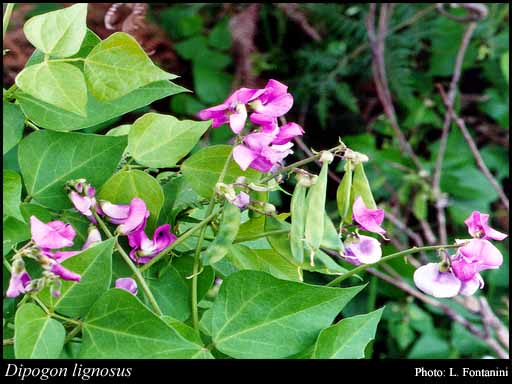- Reference
- Taxon 17:537-538 (1968)
- Conservation Code
- Not threatened
- Naturalised Status
- Alien to Western Australia
- Name Status
- Current
Twining shrub or climber. Fl. pink/purple, Sep to Dec or Jan. Gravelly soil, sand, loam. Coastal areas, creek banks, roadsides, gardens, bare areas.

Distribution
- IBRA Regions
- Esperance Plains, Jarrah Forest, Northern Kimberley, Swan Coastal Plain, Warren.
- IBRA Subregions
- Fitzgerald, Mitchell, Northern Jarrah Forest, Perth, Recherche, Southern Jarrah Forest, Warren.
- IMCRA Regions
- Eucla.
- Local Government Areas (LGAs)
- Albany, Armadale, Augusta Margaret River, Bridgetown-Greenbushes, Bunbury, Busselton, Collie, Dardanup, Denmark, Donnybrook-Balingup, Esperance, Gosnells, Harvey, Jerramungup, Kalamunda, Manjimup, Nannup, Plantagenet, Wyndham-East Kimberley.
Management Notes (for the Swan NRM Region)
General Biology. Growth form. Vine. Reproduction. Seed. Dispersal. Explosive, birds, water, soil and garden refuse. Time to first flowering. 2+ years. Vegetative regeneration strategy. coppices/resprouts. Seedbank persistence. Soil, medium, 1-5 years. Fire response. Fire can kill mature plants and stimulate seed germination.
Notes. Infestations smother all ground-flora, topple shrubs and trees and prevent any regeneration occurring. Soil disturbance generates mass seed germination.
Additional information. Origin. South Africa. History of use/introduction. Garden escape. Similar native species. Hardenbergia comptoniana.
Suggested method of management and control. Hand pull seedlings and small plants ensuring removal of all root material; sever vines of larger plants and leave to dry in canopy, then dig out woody roots; scrape and paint using 100% glyphosate or foliar spray in highly degraded sites with 1.5% glyphosate; in more sensitive sites, cut stems off at chest height, lay lower sections on ground and apply 1.5% glyphosate over them. Read the manufacturers' labels and material safety data sheets before using herbicides. For further information consult the Australian Pesticides and Veterinary Medicines Authority to determine the status of permits for your situation or state.
Management Calendar
| Calendar Type | Jan | Feb | Mar | Apr | May | Jun | Jul | Aug | Sep | Oct | Nov | Dec | Comments |
|---|---|---|---|---|---|---|---|---|---|---|---|---|---|
| Flowering | O | Y | Y | Y | O | ||||||||
| Fruiting | Y | Y | O | O | O | Y | Y | Y | |||||
| Optimum Treatment | O | O | O | O | O | O | Y | Y | O | O | Best before fruit develops |
Legend: Y = Yes, regularly, O = Occasionally, U = Uncertain, referred by others but not confirmed.
References
- Hussey, B.M.J., Keighery, G.J., Dodd, J., Lloyd, S.G. & Cousens, R.D. (2007) Western Weeds. A guide to the weeds of Western Australia. 2nd Edition. The Plant Protection Society of Western Australia, Victoria Park.
- Moore, J.H. & Wheeler, J. (2008) Southern weeds and their control. DAFWA Bulletin 4744.
- Muyt, A. (2001) Bush invaders of South-East Australia: A guide to the identification and control of environmental weeds found in South-East Australia. R.G. & F.J. Richardson, Melbourne.
- Natural Resources and Environment (1997) Dolichos Pea. URL: http://www.dpi.vic.gov.au/dpi/nreninf.nsf/Home+Page/DPI+InfoSeries~Home+Page?open - Accessed December 2007. Notes Series No. CW0003. Coast Action/Coastcare, Coastal Notes.
- Paczkowska, G. & Chapman, A.R. (2000) The Western Australian flora: A descriptive catalogue. Western Australian Wildflower Society (Inc.), Western Australian Herbarium and Botanic Gardens and Parks Authority, Perth.